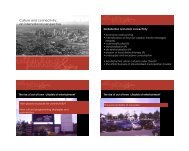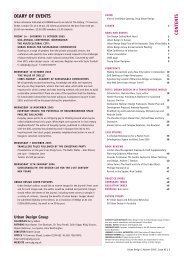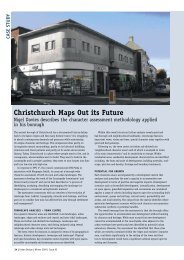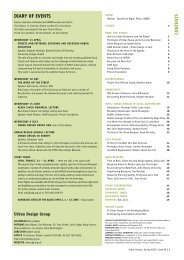URBAN MORPHOLOGY - urban-design-group.org.uk
URBAN MORPHOLOGY - urban-design-group.org.uk
URBAN MORPHOLOGY - urban-design-group.org.uk
You also want an ePaper? Increase the reach of your titles
YUMPU automatically turns print PDFs into web optimized ePapers that Google loves.
Left The typical big mess looks the same in every<br />
American suburb<br />
Opposite page The disorderly, wildly scaled<br />
environment along the main arterial contrasts with<br />
orderly nearby subdivisions. Cincinnati, Ohio 1994<br />
TOPIC<br />
Parking needs to be<br />
shoved to the back,<br />
so pedestrians can<br />
have a presence on<br />
the street<br />
approval. Zoning has very minimal consequences for physical<br />
development, mostly controlling land use (in America, an<br />
economic term rather than typological one) and setbacks or<br />
land cover. Subdivision approval depends on conformance with<br />
standard street widths and utilities and rarely is the evaluation<br />
of the plan itself a question. While both of these could be used to<br />
develop friendlier and better-<strong>design</strong>ed areas, they usually are not.<br />
In any case, both are ill-fitted tools for <strong>urban</strong> <strong>design</strong>.<br />
Current commercial types are another resistant force.<br />
Today’s stores are completely out of scale with the idealised<br />
neighbourhood business district. Even the most minimal<br />
grocery stores have a footprint that would overwhelm a walking<br />
district, which demands a comfortable distance between stores.<br />
Parking needs to be shoved to the back, so pedestrians can have<br />
a presence on the street – with large and deep stores, customers<br />
have to enter from the rear (isn’t this really just a backwards strip<br />
centre?) or walk more than 100 feet from the edge of parking<br />
along the wall of a large store. Drive-in banks and fast food,<br />
gas stations, tire centres, auto dealers, and huge home centre<br />
stores also have no place in the idealized village because these<br />
typologies demand a car dominant culture.<br />
The large size of stores and their consolidation into<br />
unrelenting corporate formulas is the result of economies of<br />
scale, distribution systems and fierce competition. Of course the<br />
larger commercial typologies are only the beginning - the large<br />
grocery store eventually gives way to the super, mega, giga-store.<br />
When neighbourhood business districts were contained within<br />
neighbourhoods, there were one or two of them occurring about<br />
every square mile. Their catchment areas were small, and the<br />
scale of retail square footage was small, about 50-70,000 square<br />
feet altogether for many small stores. Traffic coming to and fro<br />
was neighbourhood traffic, some of it on foot, making it not a bad<br />
next-door neighbour, even for a single-family house. Now, that<br />
amount of retail footage, much more efficiently laid out, can be<br />
found in a single large drug store, which naturally has to serve a<br />
much larger catchment area, which means more people and more<br />
traffic. Move up a scale to the super-centre, itself more than four<br />
times the size of a single neighbourhood business district and<br />
pulling from many miles. Even more traffic and huge parking and<br />
delivery systems make it a miserable neighbour, and it demands a<br />
high-volume street, not a little neighbourhood street.<br />
The demand for retail locations with<br />
high volumes of traffic has gone hand<br />
in hand with the development of the<br />
pattern of development in the suburbs<br />
that funnels all local traffic in a sector<br />
into one arterial, by means of the lack of<br />
connection between subdivisions. The<br />
resulting quiet streets of the housing are<br />
thus a contributor to the cancer itself.<br />
It turns out to be much easier to<br />
make the fundamental changes in the<br />
residential fabric that new <strong>urban</strong>ism<br />
and smart growth advocates suggest<br />
(smaller lots, connected streets, alleyways,<br />
housing type mix) than to tackle the<br />
problem of commercial strips. One can<br />
even build small commercial villages<br />
within these idealised neighbourhoods,<br />
but these cannot displace the strip itself.<br />
Fundamental international distribution<br />
systems, an entire real estate finance<br />
industry, huge international corporations,<br />
an ingrained expectation about the<br />
role of planners, common real estate<br />
development typologies, and even the nice<br />
people on their cul-de-sacs will continue<br />
to overwhelm the ideal. The big mess will<br />
continue.<br />
Brenda Scheer is the Dean of the College of<br />
Architecture and Planning at the University of Utah.<br />
She is a planner and an architect.<br />
Urban Design | Winter 2005 | Issue 93 | 27







